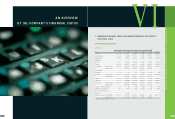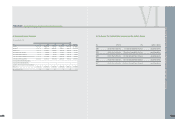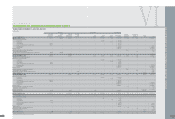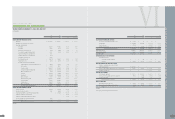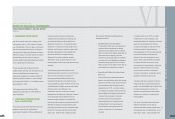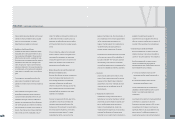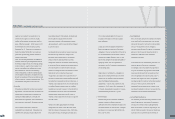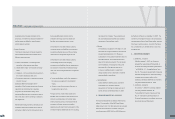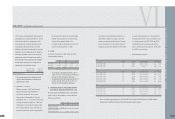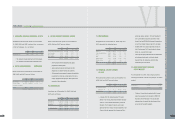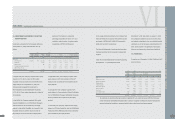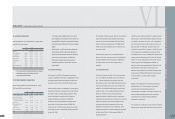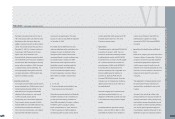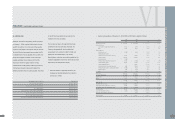HTC 2007 Annual Report Download - page 60
Download and view the complete annual report
Please find page 60 of the 2007 HTC annual report below. You can navigate through the pages in the report by either clicking on the pages listed below, or by using the keyword search tool below to find specific information within the annual report.
115114
AN OVERVIEW OFTHE COMPANY'S FINANCIAL STATUS
VI
equity in an investee's net assets when an
investment is acquired or when the equity
method is first adopted is amortized over five
years. Effective January 1, 2006, based on the
revised Statement of Financial Accounting
Standards No. 5 - "Long-term Investments in
Equity Securities" (SFAS No. 5), investment
premiums, representing goodwill, should no
longer be amortized.
When the Company subscribes for additional
investee shares at a percentage different from
its existing equity interest, the resulting change
in the Company s equity in the investee s net
assets is recorded as an adjustment to long-
term investments, with the corresponding
amount charged or credited to capital surplus.
On the balance sheet date, an impairment loss
should be recognized if the recoverable amount
of the investment is below carrying amount. This
loss should be charged to current income.
> Prop
e
r
t
i
e
s
Properties are stated at cost less accumulated
depreciation. Interest incurred in connection with
the purchase or construction of properties is
capitalized. Major additions, renewals and
betterments are capitalized, while maintenance
and repairs are expensed in the period incurred.
On the balance sheet date, assets are
evaluated for any impairment. If impairment is
identified, the Company should evaluate the
recoverable amount of the assets. An impairment
loss should be recognized whenever the
recoverable amount of the properties is below
carrying amount, and this loss should be charged
to current income.
An impairment loss recognized in prior years can
be reversed only if there is a change in the
estimates used to determine the recoverable
amount since the last impairment loss was
recognized. However, the amount reversed is only
to the extent that the increased carrying amount of
an asset should not exceed the asset carrying
amount (net of depreciation) that would have been
determined had no impairment loss been
recognized in prior years. An impairment loss of
an asset revalued under certain regulations should
be treated as a revaluation increment decrease. A
reversal of an impairment loss on a revalued asset
is credited directly to equity under the heading
revaluation increment. However, to the extent that
an impairment loss on the same revalued asset
was previously recognized as profit or loss, a
reversal of that impairment loss is also recognized
as profit or loss.
Assets held under capital leases are initially
recognized at the lower of their fair value at the
start of the lease or the present value of all future
lease payments plus the bargain purchase price.
The corresponding liability to the lessor is
included in the balance sheet as a capital
lease obligation.
Lease payments are apportioned between
finance charges and reduction of the lease
obligation to have a constant rate of interest on
the remaining balance of the liability. Finance
charges are charged directly to gain or loss.
But if these charges are directly attributable to
qualifying assets, they are capitalized in
accordance with the Company's general policy
on borrowing costs.
Depreciation is calculated on a straight-line
basis over the estimated service lives of the
assets plus one additional year for salvage
value: buildings(including auxiliary
equipments) - 3 to 50 years; machinery and
equipment - 3 to 5 years; office equipment - 3
to 5 years; transportation equipment - 5 years;
and leasehold improvements - 3 years.
> D
e
f
e
rr
e
d Ch
a
rg
e
s
Deferred charges are telephone installation
charges, computer software costs and
deferred license fees. Installation charges and
computer software are amortized on a straight-
line basis over 3 years, and deferred license
fees, over 10 years.
> Ass
e
t
Imp
a
i
rm
e
n
t
If the recoverable amount of an asset is estimated
to be less than its carrying amount, the carrying
amount of the asset is reduced to its recoverable
amount. An impairment loss is charged to
earnings unless the asset is carried at a revalued
amount, in which case the impairment loss is
treated as a deduction to the unrealized
revaluation increment.
If an impairment loss subsequently reverses, the
carrying amount of the asset is increased
accordingly, but the increased carrying amount
may not exceed the carrying amount that would
have been determined had no impairment loss
been recognized for the asset in prior years. A
reversal of an impairment loss is recognized in
earnings, unless the asset is carried at a revalued
amount, in which case the reversal of the
impairment loss is treated as an increase in the
unrealized revaluation increment. A reversal of an
impairment loss on goodwill is disallowed.
> A
cc
ru
e
d M
a
r
k
e
t
i
ng Exp
e
ns
e
s
The Company accrues marketing expenses on the
basis of agreements, management's judgment,
and any known factors that would significantly
affect the accruals. In addition, depending on the
nature of relevant events, the accrued marketing
expenses are accounted for as an increase in
FINANCEI INDEPENDENT AUDITORS' REPORT
l


